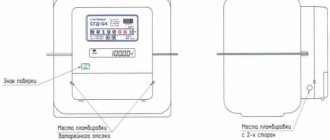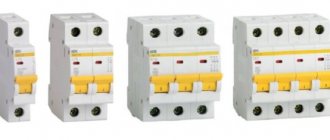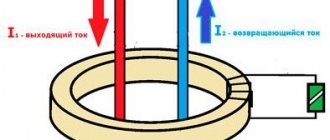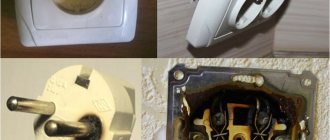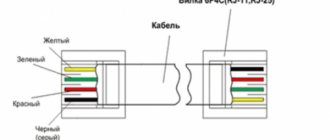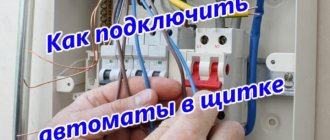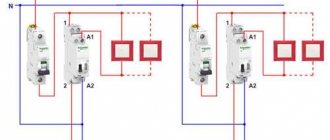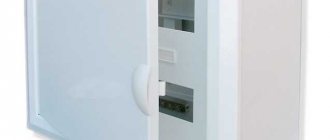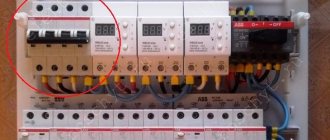Option 1
This is the simplest circuit of an input panel with an electricity meter. It shows the TN-S grounding system, that is, when separate independent neutral working and neutral protective conductors come from the power source. In this single-phase switchboard circuit, there is a two-pole circuit breaker at the input.
Here and in subsequent diagrams, the ratings and characteristics of protective devices are chosen arbitrarily. Yours may differ, but the very essence of the connections between circuit breakers and other protective devices remains the same.
After the opening machine there is a counter. To register it, the input switching device and the electricity meter itself must be sealed. Next come single-pole group circuit breakers. The phase is always supplied to the circuit breakers, and the zero to the zero bus. It turns out that all neutral working conductors of different groups are combined with each other, and phase conductors are switched using automatic machines.
This version of the scheme is the simplest and is very often found at various sites.
Electrical panel assembly process
After installing the housing and inserting the cables into it, the electrical panel can be assembled and connected. To do this, you need to perform the following series of operations:
- First of all, 35 mm DIN rails are installed. They will install automatic machines, an electric meter, and busbars for connecting grounding conductors and neutral wires separately. They are secured to the rail using a latch. It is designed in such a way that the elements can be moved freely.
- Then the required number of elements is installed in accordance with the diagram and two buses. The power cable is connected to the input circuit breaker, which is placed first on the top left. It is advisable to enter it from above for convenience.
- We connect the input machine. It is recommended to connect the phases from below to make it more convenient to install jumpers from above.
- After this, the machines are connected by jumpers and the assembly of the circuit begins in accordance with the diagram. Zero is taken from the zero bus for each machine separately. The yellow-green wire of the machine is connected to the ground bus. The housing and door of the metal housing are connected there using a copper wire.
To avoid mistakes in the future, make the zero jumpers blue, and the phase jumpers different from it.
The transfer or installation of the electrical panel should be carried out only after turning off the power to the apartment. If you doubt your capabilities, it is better to entrust the assembly procedure to a specialist or do everything under his control.
After assembling the electrical panel, all that remains is to screw on the cover and check the result by applying voltage.
Carrying out work on moving the electrical panel
The electrical switch that supplies electricity is usually located in a single panel on a common area. This often brings inconvenience. Placing a panel with machine guns in your living space is more convenient for many.
To transfer the shield from the site, it is necessary to develop technical documentation and coordinate the project with regulatory organizations. This will be done by Yudu performers who know how to correctly move an electrical panel. Specialists perform the following tasks:
- calculations (in accordance with the parameters of the installed machines and the characteristics of the electrical wiring)
- dismantling the batch switch, old automatic power supply, wires and plugs
- installation of a new machine in your apartment
- installation of a protective grounding device, as well as an overvoltage relay (for protection against power surges in the network)
transferring a panel with machine guns to an apartment of any size
Yudu performers are highly qualified and have extensive experience. Masters will be able to quickly install any machine using special equipment. The performers have all the consumables to move any electrical panels from the entrance. The selected contractor will draw up a project for moving the electrical panel, taking into account the peculiarities of load distribution. Professionals will carry out the transfer of electrical panels from the staircase landing efficiently and quickly.
Relocating an electrical panel in an apartment or private house
There may be many reasons why it becomes necessary to move the electrical panel. The easiest way to do such work is in a new apartment. In this option, repair work is still carried out and nothing interferes with the owner.
During construction, savings are made on everything, including electrical equipment. Often builders use the cheapest. At the same time, no one even hides the installation box in the wall.
In this regard, homeowners want to make the appearance of the electrical panel more aesthetic and install it in the most convenient place. Also, many strive to comply with safety rules.
It is also possible to leave it in the same place, while simply replacing the protection devices and checking in detail how well the wires are laid. Additionally, you will need to install new machines. They must match the power of the home owner’s equipment.
Share article on social networks
Which electric meter should I choose for outdoor installation?
There are household electricity meters designed for installation outside the home. They are able to withstand fluctuations in air temperature while maintaining accurate readings.
The devices are single- and multi-tariff, single- or three-phase.
Street meters come in different capacities.
To determine it, you need to calculate the total power of all electrical appliances in the room. If it is below 10 kW, then a 60 A meter is suitable, if more - 100 A. The accuracy class must be at least 2.0.
Devices are now being produced that work well even at low temperatures.
When purchasing an installation box, you need to pay special attention to its tightness. Heating is not required
The moisture-resistant box must have a degree of protection of at least IP53-IP54.
The box should be selected taking into account the design of the meter.
It is necessary to have a window on the door to take readings.
As an outdoor option, a single-phase electric meter is most suitable - for a small house and cottage, or a three-phase one - for a multi-storey cottage with a swimming pool, sauna, etc.
In the latter case, the main thing is to correctly connect the device and evenly distribute the load on the network circuits.
Electric meters have a higher accuracy class than induction meters. The readings remain stable despite temperature changes throughout the entire service life.
When selecting the type of device mounting, it is better to give preference to a DIN rail. It is universal.
Before purchasing, you need to pay attention to the seal and the date of the last verification. Its age should not exceed two years - for single-phase devices and 1 year - for three-phase
Calibration interval
Depending on the model, the device can last up to 25 years. In addition, there is also a shelf life and guaranteed performance. They all differ from each other. To link these terms, the meter interverification interval (MPI) is used. It determines how many years of operation the device will withstand within a given error. The quality of different meter models varies, and the inspection frequency can range from 4 to 16 years.
When releasing a new product, the manufacturer's accredited service checks the accuracy of the readings and seals the device. PUEs require that there be a seal with the manufacturer's mark on the screws that secure the meter casing.
What to do after the transfer
Installation of the device at a new place of operation is carried out by a representative of energy sales. But the owner of the site needs to ensure that the device is put into operation correctly and that all necessary documents are completed:
- In order for the meter to be put into operation, you need to submit an application to the energy company. It indicates the consumer’s passport details, his contacts, and the number of the contract with the supplier.
- A company representative will fill out the documents and indicate the arrival time of the specialist to install the seal. The first sealing should be free.
- After putting the meter into operation, you need to make sure that it is reliably protected by a special shield with a transparent window for reading readings.
Assembly and installation of an electrical panel in a house, apartment, or country house
Installation and assembly of an electrical panel is a complex job that requires a clear sequence, where every action is important and cannot be neglected.
The main qualities of the device are safety and ease of use.
- accounting for electricity consumption;
- circuit management;
- protection of the circuit from fire due to overload.
It is possible to install an electrical panel in a house, apartment or country house on your own, but to do this you need to have basic knowledge and skills as an electrician.
Electrical panel project
For a person who is far from electricity, it is better to start designing an electrical panel when the wiring installation is completely ready and the wires are brought to the location of the future electrical panel. First you need to draw up drawings for the work and select suitable components.
Consumer calculations
A complete list of consumers is compiled. To do this, you do not need to take into account devices like a fan or a table lamp, but write down and number each wire connected to the panel. Sockets must be recorded separately, lighting - separately. High-power appliances (boilers, washing machines, air conditioners, electric stoves) require wiring protection from overload, so they are connected not through distribution boxes, but directly to the panel.
The list of consumers for a three-room apartment usually looks like this:
- sockets:
- bedroom;
- living room;
- children's;
- kitchen;
- bathroom;
- entrance hall and corridor.
- Washing machine;
- boiler;
- air conditioner;
- electric stove;
- lighting:
- bedroom;
- living room;
- children's;
- kitchen, bathroom;
- hallway, corridor.
All consumers are divided into groups (circuits) in accordance with power consumption: sockets for household appliances in one room such as an iron, sconce, TV and others can be combined into one group (sockets in one room - one group, in another - another), lighting - to the next one, also by room. Each group has its own circuit breaker (or just a circuit breaker) on the panel, and for high-power appliances - washing machine, boiler, electric stove, air conditioner - there is one separately for each. Machines may also be called fuses or bags.
Next, the list is converted into a table where the ratings of the machines and RCDs are entered.
Drawing up an electrical panel diagram
The electrical panel is a housing - a metal or plastic box - with modules inside. A module is a component that occupies one installation “space” (within one DIN rail). Some devices can take up two or even three “places”.
For clarity, you should create a diagram according to which the shield will be assembled.
Examples of 220 V switchboard circuits:
- introductory machine;
- electric meter;
- RCD (residual current device);
- ground bus;
- "zero" bus;
- automatic sockets for high-power devices at 25 A;
- automatic socket group for household appliances of low and medium power at 25 A;
- automatic lighting 16 A;
- L—phase;
- N - zero;
- PE - grounding.
Each house or apartment will have its own layout in accordance with the preferences of the owners.
Selection of components
Depending on the position on the wall, the electrical panel can be of two types:
- internal - recessed into the wall, slightly protruding;
- external - the body is not recessed, but simply fixed to the wall.
If the wiring in the house is hidden inside the walls, then an internal shield is more suitable. It takes up less space and is not particularly conspicuous, since it protrudes from the wall minimally. To install such a shield, you must first prepare a niche in the wall for it. The wall thickness must be suitable.
If the wiring goes over the walls, then an external panel is suitable, which does not require preliminary preparation of the site. It is enough to attach the housing to the wall with self-tapping screws or dowel nails.
An external electrical panel can be installed both inside the house and in the yard on a pole.
It is better to choose a case from proven European companies with removable walls. It is desirable that the DIN rails are also easily removed or moved aside. You should not take frankly cheap cases: they are made of low-quality plastic, which dries quickly and becomes brittle, is not self-extinguishing and smokes heavily when ignited. Good cases are already ready for wiring inside, but cheap ones will have to be completed.
After installing the housing, you need to select automatic machines, RCDs, difautomatic devices (automatic and RCD in one), a meter, contactors and other devices. Additional modular sockets, buses, power supplies, and control devices can be installed on DIN rails.
When selecting modules, you need to consider the following parameters:
- rated current;
- speed of operation of machines;
- shutdown current of automatic machines, difavtomats, RCDs;
- permissible operating frequency for contactors.
The machines are selected separately for each circuit so that the system is balanced. So, if you allocate a 6-10 A circuit breaker for high-power devices, the latter will automatically turn off, preventing the equipment from working, and, conversely, an overly powerful circuit breaker installed for a low-power consumer will not protect the wiring from overload. For lighting, 6-10 A automatic circuit breakers are used, ordinary household sockets, boilers, air conditioners, washing machines - 16 A, electric stoves - 20-25 A. An input circuit breaker is needed for 32-60 A, depending on the total current strength of all consumers of the facility.
In the event of a power surge, the circuits should be turned off independently of each other, preferably in order “from lower to higher,” which makes it possible not to de-energize the entire house in case of problems and makes it easier to detect them. Therefore, the machines are equipped with a “set” for the response time: first the lower one is turned off (0.1 s), then the higher one (0.5 s).
A suitable RCD is one whose rated current is higher than the total current of the machines subordinate to it. So, during a surge, the circuit breakers will turn off first, preventing damage to the RCD. For a 16 A machine, a 20-25 A RCD is installed; a 25 A electric stove machine requires a 40 A RCD.
An integral element of the system are the zero and ground buses - copper strips with holes into which wires are inserted and clamped with a bolt. The bar is placed on a dielectric insulator, which is mounted on a DIN rail.
Assembly and connection
Assembly and connection of the electrical panel requires strict adherence to safety precautions! It is better to place the modules in the shield housing according to the drawn up diagram.
Work order:
- 35 mm DIN rails are installed for the meter, machines, zero and grounding buses;
- automatic machines, RCDs and two buses are installed, to which neutral and grounding wires are connected. The input circuit breaker, to which the power cable of the entire system is supplied, must be installed first in the upper left corner of the case. For convenience, it is better to connect the cable to the machine from above. The excess holes remaining in the case for supplying wires are closed with plugs;
- The input machine is connected depending on its type:
- phase and zero are connected to the two-pole;
- to single-pole - only phase;
- in 380 V switchboards, three phases are connected to the input circuit breaker.
- It is better to connect the phases to the machine from below for the convenience of installing jumpers between the machines from above;
- all automatic devices and RCDs are equipped with special copper busbars in insulation or with ordinary wires of sufficient cross-section. The blue neutral wire from the input cable is connected directly to the neutral bus. When connecting RCDs and automatic circuit breakers, you need to connect the zero to the bus from each separately;
- route and connect the cables to the machines according to the diagram. Neutral wires are indicated in blue, phase wires in red, ground wires in black and yellow.
Private homes and offices are often equipped with 380 V electrical panels. A 4 or 5-core cable is supplied to such a panel: two or three phases, neutral and ground.
The 380 V switchboard diagram will be as follows:
Three phases are connected to the input circuit breaker, after which they go to the meter. Then the phases go to a common circuit breaker, after which the wiring is divided into single-phase lines for 220-volt devices and three-phase lines for 380-volt equipment. The voltage between different phases is always 380 V, and between zero and any phase - 220 V.
Household sockets must always be supplied with zero and a phase, 220 V. If you supply two phases, 380 V, the equipment will quickly fail.
The grounding wire always bypasses the machines and goes from the grounding bus to the sockets. Grounding from the input cable also goes directly to the bus. Zero is connected directly from its bus if the sockets are connected through ordinary machines. If they are connected through an RCD or a circuit breaker, zero passes through them.
At the end of the work, the shield is closed and voltage is applied to it.
Watch the video on the topic:
Drawing up an electrical diagram
This step is required. This is due to the following factors:
- when upgrading the electrical network or repairing it, it will be possible to quickly determine which section each element is responsible for. This is also true if you plan to transfer the shield;
- In order for an electrician to accept the work carried out, a diagram is required;
- With the diagram, assembling the shield is much easier.
A diagram is drawn up in several stages:
- The power supply system for the house is determined.
- Electricity consumption points are divided into several groups.
- Based on this data, a scheme is formed.
The method of connecting and grounding the panel depends on the type of power supply.
You can find out the type of power supply and grounding system at home by looking at the panel, if it is being moved, or by contacting the relevant authorities. In modern houses, the TN-S or TN-CS system is more often used. A three-core copper wire is laid throughout the apartment, and a cable having three phases, neutral and PE ground is connected to the distribution board on the floor.
In older buildings, the TN-C system can be used, where a two-core aluminum and copper cable is laid throughout the apartment, and a cable with three phases and one PEN conductor, in which neutral and ground are combined, is connected to the distribution panel.
The breakdown of consumption points can significantly simplify installation work and save materials. Experts recommend dividing them into the following groups:
- sockets throughout the premises;
- switches and lighting for rooms;
- the most powerful consumers (microwave, dishwasher or washing machine, boiler) should be allocated with separate automatic machines.
Approximate wiring diagram for 3-4 apartments
Different machines are used for different consumers:
- 16A RCD for switches;
- RCD for 16-20A for sockets;
- 25A RCD for household appliances;
- RCD 32-63A for electric stove.
You can draw up a diagram yourself if you have certain skills and knowledge of notation. But it is better to have a qualified electrician do this. He will be able to take into account all the nuances.
requirements for the location of the panel on the wall
I remember a rule that goes something like this (I read it somewhere, but forgot where): from the floor to the top edge of the shield there should be no more than 2 m and from the floor to the topmost object in the shield - no more than 1.9 m
Where could this be written, please remind me (as soon as possible)? or did I mess something up?
Well, or in general, where are the requirements for the location of the shield on the wall?
Well, somewhere it should be said that the shield cannot be placed too high, diagonally, with the door inside the wall
and so on.
There is something missing in the Pue, perhaps there is some kind of guest?
Will your shield be with or without a meter? For example, I have it hanging on a support about four meters from the ground.
When I bought the house, the meter and plugs were almost hanging from the ceiling. To look at the readings and change. if you needed a traffic jam, you had to climb onto the tambourette. Not convenient. I replaced all this with a normal cabinet with a counter and automatic machines. When I reported this to the energy sales office, they praised me and allowed me to do it with all sorts of encouragement. I read in some book that the bottom of the counter is no higher than 170 cm from the floor. I asked the power supply company what height to hang it at. A figure of 170 cm was named, but a little higher is possible. The main thing is that the guy with the ice cream doesn’t start swearing, which is too high for him. That's what I did. The counter itself is at head level, the input machine is separate at a height of approximately 200 cm. There were no complaints.
Where are electricity meters located in an apartment building?
.
Important links
useful links
- 10 KILOVOLT »
- Articles "
- Electricity meters »
- Rules for installing electricity meters in an apartment building
How to install an electric meter in an apartment building.
When installing a meter in an apartment building, the most important question is at whose expense the electric meter is installed, and who is responsible for this property. Our specialists have experience with meters in apartment buildings - both communal and individual meters.
We are ready to help solve difficulties that may arise when replacing or moving an electric meter into an apartment. Call – our specialists are ready to give comprehensive advice.
Common house electricity meter at the entrance
Household electricity meter
The rules for installing electric meters in an apartment building do not regulate issues of ownership and payment when replacing or moving an electric meter.
This issue is resolved in accordance with Part 2 of Art. 543 of the Civil Code of the Russian Federation. According to this document, the energy supply organization must ensure the technical condition and safety - unless otherwise established by legal acts or laws.
There is Government Decree No. 530 dated August 31, 2006, which determines the procedure for design, installation work and commissioning of metering devices. This resolution clearly states that the owner of the object (the owner of the premises) is obliged to ensure its safety and integrity.
In judicial practice, this disagreement is interpreted as follows: if the electric meter is located in the entrance, it is the common property of the house, which means that the burden of its maintenance and safety is determined by the agreement concluded by the residents and the management company.
Typically, the contract provides for two options: carrying out work for an additional fee, or at the expense of funds that the company collects from residents.
Thus, the replacement of electricity meters in an apartment building, if the meter is located in the entrance, is in any case carried out by the management company, but the issue of financing this process is determined either by an agreement or by a general meeting of residents - if this item is not regulated by the agreement.
The installation location of the electric meter in an apartment building is selected based on considerations of safety, convenience and the requirements of the PUE rules.
Electric meter inside the apartment
If the metering device is located inside the apartment, it is the property of the property owner, which means that the burden of maintaining and maintaining the technical condition lies with the owner of the premises.
In this case, replacement, installation, as well as transfer of the electric meter from the entrance to the apartment is carried out at the expense of the apartment owner.
The balance limit is determined by the size of the apartment: all communications that are located inside are repaired and maintained at the expense of the owner of the premises, those outside the apartment are for the management or energy-saving class=”aligncenter” width=”800″ height=”800″[/img ]
The specialists of 10 Kilovolt LLC have extensive experience and have connected a significant number of objects to the networks. Our employees have all the permits and certificates that give them the right to connect electricity and install electricity meters. Upon completion of the work, a certificate of replacement or reprogramming of the electric meter is provided.
Where should the electric meter be located in an apartment building?
The date of verification is indicated on the seal of the meter body, Roman numerals indicate the quarter of the last check, and Arabic numerals indicate in which year it was checked. These deadlines are also regulated by the PUE. Requirements for the switchboard The basic standards do not have clear requirements for the design features of electrical switchboards. However, there are still certain conditions:
- there must be free access to the terminals of the electric meter and to the current transformer;
- it is necessary to ensure the possibility of comfortable replacement of equipment;
- so that there are no obstacles to installing the meter at an angle of up to one degree;
- It is very important to ensure that all installation and repair work is carried out from the outside of the equipment.
To attach electric meters, it is allowed to use panels made of wood, plastic and metal.
The wait for a response is about 1 week, since the application is entered into the register;
- After this, you should get a certificate from the energy company and you can go with it to purchase a meter;
- The equipment will come with a device passport, where all the parameters are indicated. Documentation should be retained.
What is required from the documents In old apartment buildings, inspections of electrical equipment are often carried out. It is then that the unsuitability of the devices is revealed, for example, the service life has expired or it has broken down.
Replacing electricity meters in an apartment building
- You must write a statement regarding the replacement of equipment. It must be taken to your local electricity authority.
Rules for installing an electric meter in a private house, apartment, or on the street
Newly installed three-phase meters must have state verification seals not older than 12 months.
, and on single-phase meters - no more than 2 years old. 1.5.27. Meters must be located in dry rooms that are easily accessible for maintenance, in a place that is sufficiently free and not cramped for work, with a temperature in winter not lower than 0 ° C. It is allowed to place meters in unheated rooms and corridors of switchgears of power plants and substations, as well as in outdoor cabinets.
1.5.30. In places where there is a danger of mechanical damage to meters or their contamination, or in places accessible to unauthorized persons (passages, staircases, etc.), a locked cabinet with a window at dial level should be provided for meters.
Replacing an old electricity meter with a new one
Each house has a meter installed to measure electricity. Its location is the entrance of an apartment building. Often it is installed in an apartment. Each device has its own expiration date, during which it can function normally. Then replacement is required.
Devices can also fail. They can be installed either in the same place or moved to another. For example, at the entrance. Equipment removal is usually required outside the city. Since 1996, GOST 6570-96 came into force, according to which it is prohibited to use devices with an accuracy of 2.5 and a current of less than 30 A. It was decided to replace the devices after the verification interval with new meters with an accuracy of 2.0 (2% error). Therefore, the meter is changed in each apartment, although its deadline may not have passed yet. If the owners of the premises installed a device with an accuracy class of at least 2.0, then they are confiscated.
At whose expense are electricity meters replaced: rules and procedure
First of all, the consumer of electricity should know that everything related to the operation of electricity meters is regulated by the Electrical Installation Rules (PUE). Installing electricity meters in an apartment is not prohibited, but has its own characteristics. Content
- 1 Availability of state verification
- 2 Shield requirements
- 3 Installation rules
- 4 Security measures
- 5 Installation in residential buildings
- 6 Features of accommodation in private houses
- 7 Installation at dachas
Availability of state verification You can install electricity meters in residential premises if you have a state verification, the deadline for which has not yet passed.
Where should the electric meter be located in an apartment building?
The electric meter may fail, its service life may expire, it may become technically outdated, or a subscriber of the energy supply company may want to install a more modern multi-tariff device that can significantly save money spent on electricity. The content of the article:
- What is it regulated by?
- Who changes and at whose expense?
- In a privatized apartment
- In public housing
- At the entrance
- In a private house
- Rules and terms
- If it's broken
- Can I replace it myself?
- Procedure
- Is notification sent?
- Checking and sealing
- What documents are issued?
Dear readers! Our articles talk about typical ways to resolve legal issues, but each case is unique. However, the law stipulates the possibility of payment for work by the owner of the apartments, if such a provision is specified in the agreement between the owner of the residential premises and the manager class=”aligncenter” width=”1200″ height=”900″[/img]
If this is not specified in the contract, then all costs must be borne by the management company. In a private house, the owner of a private house fully pays the costs of replacing a failed electric meter in accordance with Russian Government Decree No. 530, since he is the owner of the residential premises. In those rare cases when the user of the energy supply company lives in the municipal private sector, replacement of electricity meters is carried out in the same manner as in municipal non-privatized apartments. Rules and Deadlines When replacing an electric meter, there are strict rules that must be followed.
It is suitable for remote installation when the meter needs to be moved to another location. Electronic meters The operation of these devices differs from previous ones. They are based on mechanics, and the current flows directly to semiconductors and microcircuits.
This is necessary for energy accounting. The device has an electronic display for displaying information. The benefits include:
- Small size;
- You can take into account energy consumption at different tariffs;
- Accounting occurs accurately;
- There is an electronic scoreboard;
- Readings are easily written off.
Disadvantages include high cost and short service life. Many residents prefer to install these devices in their apartments. Replacement of any equipment must be carried out by a specialist. Types of electricity meters Various devices are used for apartment buildings.
Where should the electric meter be located in the apartment or on the site?
Civil Code of the Russian Federation;
- Housing Code;
- Federal Law No. 261 of November 32, 2009;
- Federal Law No. 102 of June 26, 2008;
- decision of the State Standard of the Russian Federation;
- Resolutions of the Government of the Russian Federation No. 530 and No. 491.
Who changes and at whose expense? Do I need to change my electricity meter at my own expense? Depending on the location of the meter inside the apartment (private house) or in the entrance, responsibility for the condition and proper operation of the electricity meters lies with either the owner of the residential premises or the management company. You can learn how to turn off a radio point in an apartment via the Internet from our article.
In a privatized apartment In a privatized apartment, the owner of the residential premises must ensure the safety and integrity of electricity meters, as well as their maintenance.
Where should the electric meter be located in the apartment?
The height from the floor to the meter terminal box must be within 0.8 - 1.7 m. A height of less than 0.8 m is allowed, but not less than 0.4 m. 1.5.6. It is recommended to install meters for calculating the electricity supply organization with electricity consumers at the boundary between the network (according to balance sheet ownership) of the electricity supply organization and the consumer.
1.5.13. Each installed settlement meter must have seals with the state verifier's mark on the screws securing the meter casing, and on the clamping cover - a seal from the energy supply organization. The main basis for drawing up an agreement is the Civil Code of the Russian Federation. Often, the consumer of electrical energy does not fully know the requirements of the current norms and regulations in electrical installations and does not have sufficient economic and legal knowledge in the field of energy.
The electricity consumer, when signing such an agreement, is unaware of possible penalties and restrictions on the supply of electricity from the energy supply organization. Despite the fact that some such sanctions may not be entirely legal, after signing the agreement by both parties they become legally binding, since in accordance with Art. 421 clause 2 of the Civil Code of the Russian Federation “The parties may enter into an agreement, both provided for and not provided for by law or other legal acts.”
Housing and communal services in Russia.
The specific mandatory location for installation (installation) of a residential electric meter is not regulated by any current laws or regulatory and technical documents. However: - when designing apartment buildings, designers use UNIFIED STANDARD floor electrical distribution panels produced by manufacturing plants, in which apartment electricity meters are installed in these panels. - apartment electricity meters are the property of the apartment owner, and, in my personal understanding, “the owner is a gentleman” and can install the meter wherever he pleases.
Therefore, when I changed my meter (and several meters for elderly neighbors) to new electronic ones with a higher accuracy class, I installed them in the hallways of the apartments. There were no complaints, comments or objections during the registration and acceptance of meters by Elektrosbyt employees.
Good luck in installing the meter wherever you want!
Sources
- Federal Law “On the General Principles of the Organization of Local Self-Government in the Russian Federation.” Text with changes and additions for 2022 / Not available. — Moscow: Mechanical Engineering, 2017. — 178 p.
- Law and Economics No. 08/2008; Justitsinform - M., 2008. - 621 p.
- Conformity assessment methods No. 2 2007; Standards and quality - M., 2007. - 961 p.
- Yakovlev, V.N. Ancient Roman and modern Russian inheritance law. Reception of law / V.N. Yakovlev. - M.: Institute of Practical Psychology, 2005. - 128 p.
- Lyubov Aleksandrovna Sharnina Constitutional law. Tutorial; Prospect - M., 2000. - 761 p.
Relocating an electrical panel in a house or apartment
Typically, the shield is transferred in the following cases:
- Replacement of wiring in a private house during a major renovation. After its completion, the electrical box is moved from the pole into the house.
- Sometimes during construction the electrical panel is moved from the pole to the cabin.
- When moving into a new apartment.
- If there is a need to connect additional electricity consumers, and the switchboard does not meet electrical safety requirements or there is a need to increase the number of machines.
- Upon completion of the construction of the cottage, the electrical panel is moved from the pole to the house.
The easiest way to move an electrical panel is to a new apartment. Nothing bothers the owner, and repairs are still done upon move-in.
Builders are trying to save money both on materials and on work. They install the cheapest machines in the panel, and the box is not recessed into the wall. This is done not only in panel houses, but also in brick houses.
Therefore, when moving into an apartment, owners try to change its location so that it is aesthetically pleasing. At the same time, it did not take up any useful space and met all safety requirements. You can leave it in the same place, replacing the protection devices and checking the quality of the electrical wiring. We will have to install new machines, the ratings of which correspond to the power of the owner’s equipment. For example, as shown in the figure below.
In panel houses, a wall box is usually installed, since it is not always possible and not always permitted to cut a niche in the wall. It is located near the front door in such a way that the electrical panel is in the way and is located on the passage.
It is prohibited to ditch load-bearing walls in panel houses (according to Moscow Government Decree No. 73-PP dated February 8, 2005 “On the procedure for reconstructing premises in residential buildings in the city of Moscow”, as well as Government Decree No. 508 (Clause 11.3 and 11.11 of Appendix No. 1 Therefore, choose overhead models.But if the shield is installed on a non-load-bearing partition, then you can use built-in boxes.
The owner does not have to turn off the electricity so often. Therefore, it is advisable to leave it near the front door and move it to a convenient place. But the top of the box should not be higher than 1.8 m from the floor level. When moving from one place to another, do not forget about safety requirements. It is not recommended to place it as shown in the figure below.
In this case, turning off the electricity will be difficult, which is contrary to the requirements of the PUE. You should find another place to place it.
When replacing electrical wiring in an apartment, it is recommended to move the electrical panel from the entrance to the apartment. In this case, leave the electricity meter on the site. In this case, you can safely expand the input cable that goes from the meter to the apartment.
If the meter remains in the floor panel, then no approvals are required, and the transfer can be done with your own hands. If the owner does not have the skills to work with electricity, it is better to call a qualified specialist.
